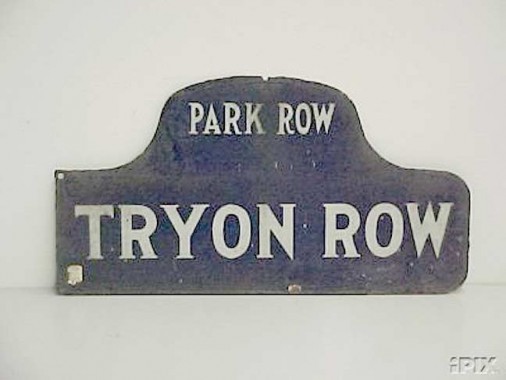There are, or were, only two streets called “Row” in New York and wouldn’t you know it, they met each other. Tryon Row was a one block street between Centre Street and Park Row just south of the Municipal Building. Tryon Row’s space is now occupied by a modest sitting space with tables and chairs. In the 1800s, the intersection marked NYC’s first public school.
Tryon Row was named for William Tryon, a Loyalist who fought with the Continental Army and served as governor of the provinces of North Carolina and New York from 1765-1780.
During the spring and summer of 1776, Tryon and New York City’s mayor, David Mathews, were conspirators in a miserably bungled plot to kidnap General George Washington and to assassinate his chief officers. One of Washington’s bodyguards, Thomas Hickey, was involved in the plot. Hickey, while in prison for passing counterfeit money, bragged to his cellmate Isaac Ketcham about the kidnapping plot. Ketcham revealed it to authorities in an effort to gain his own freedom. Hickey was court-martialled, and was hanged for mutiny on 28 June 1776…
… Tryon had long advocated engaging in attacks on civilian targets, but Clinton turned down Tryon’s proposals. In July 1779, Tryon commanded a series of raids on the Connecticut coast, attacking New Haven, Fairfield, and Norwalk, burning and plundering most of Fairfield and Norwalk. Tryon’s raids were intended to draw American forces away from the defence of the Hudson valley. In spite of pressure from Governor Jonathan Trumbull, George Washington did not move his troops. Americans condemned him for making war on “women and children”, and the British commander Clinton was also indignant about Tryon disobeying his orders. Tryon found approval of his conduct from Lord Germain, but Clinton refused to give Tryon any further significant commands. wikipedia
Nonetheless, Tryon was honored by Tryon Row, Fort Tryon Park in Inwood, and Tryon Avenue in the Bronx.
This style blue and white “humpback” signs showing the cross street were used in Manhattan and the Bronx between 1913 and about 1964, when they were replaced by vinyl and metal signs.
11/8/11
